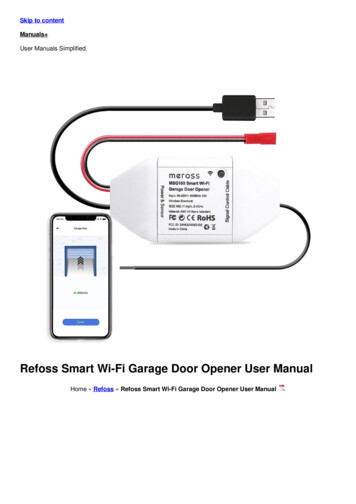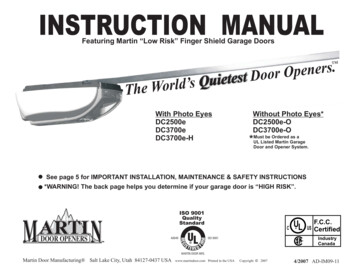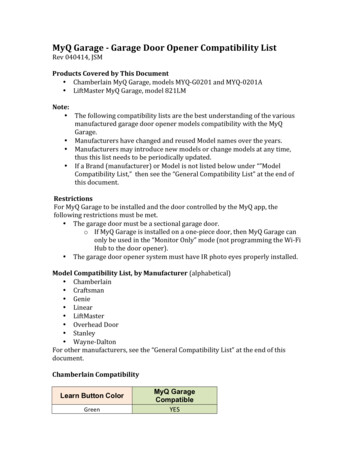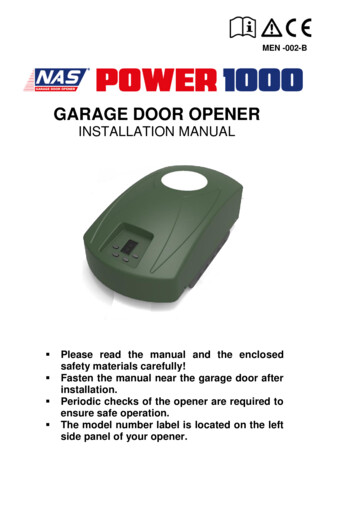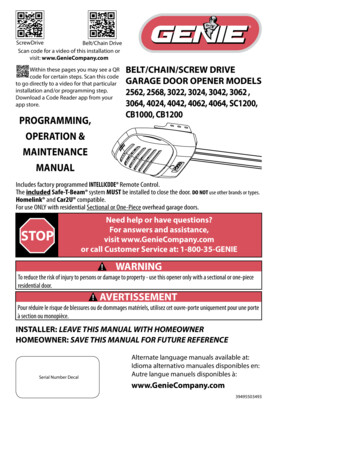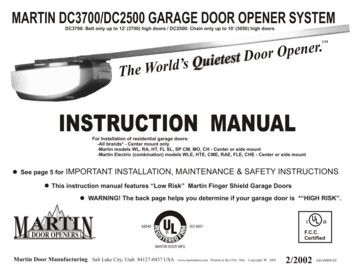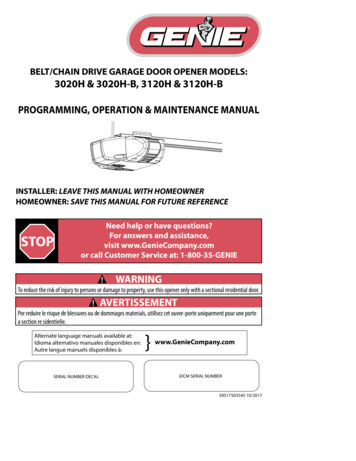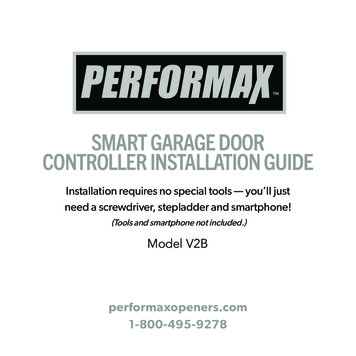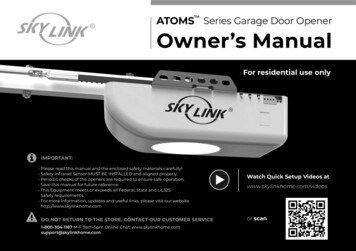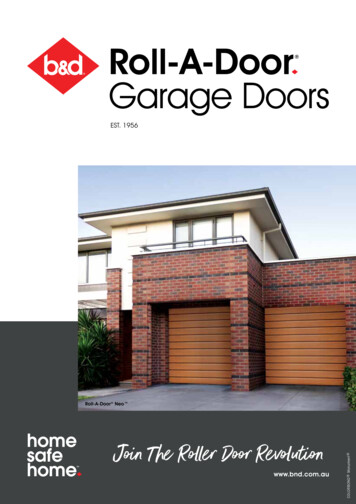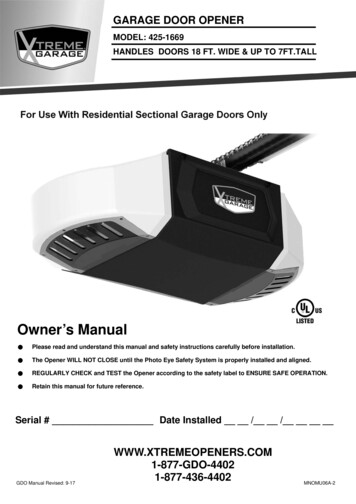
Transcription
GARAGE DOOR OPENERMODEL: 425-1669HANDLES DOORS 18 FT. WIDE & UP TO 7FT.TALLFor Use With Residential Sectional Garage Doors OnlyOwner’s Manual Please read and understand this manual and safety instructions carefully before installation. The Opener WILL NOT CLOSE until the Photo Eye Safety System is properly installed and aligned. REGULARLY CHECK and TEST the Opener according to the safety label to ENSURE SAFE OPERATION. Retain this manual for future reference.Serial # Date Installed / /GDO Manual Revised: 402MNOMU06A-2
Table of ContentsIntroductionSymbols and IconsInventoryPreparation / Door Balance TestTools Required2344AssemblyRail and Trolley AssemblyInstalling the Chain56InstallationMounting Header BracketAttaching Rail to Header Bracket and Mounting Door BracketMounting Opener to CeilingAttaching Door ArmsInstalling Light and Emergency Release Handle7891011WiringWiring InstructionsConnecting Photo Eye Safety SystemConnecting Push ButtonConnecting Power12131415AdjustmentAligning the Photo Eye Safety SystemTravel Limit AdjustmentForce AdjustmentFinal Adjustment and Testing15161718OperationProgramming Hand-held Transmitter - HomeLink CompatibilityProgramming Wireless Keyless Entry PadOperating the OpenerMaintenanceTroubleshooting192021 222323Repair Parts and ServiceInstallation and Accessory PartsOpener Assembly parts2425Warranty26Symbols and Icons!WARNINGREAD WARNINGS CAREFULLY to prevent SERIOUS INJURY or DEATH caused byelectrocution or mechanical hazard.DO NOT connect powerPlease connect powerCourtesy light turns on/flashes with audible ‘click’.(If light bulb is not installed, ‘click’ represents the light)2Installation hardwareshown in actual size
InventoryRail — Header SegmentRail — Middle Segments x3Opener Unit Light LensPhoto Eye Safety SystemRail — End Segment with Trolley Stop Boltx4Screw #6 x 1-3/8”x4Drywall AnchorHandheldTransmitterPush ButtonEmergency Release Handle RopeTrolleyPulleyHeaderBracketKeyless Entry PadTrolley ShaftChainHangingBracketsSprocket CoverLiterature Safety LabelsDoor BracketDoor ArmsINSTALLATION HARDWARE, LOCATED IN HARDWARE BAG (SHOWN IN ACTUAL SIZE 1:1)x2x2x1Clevis Pin — Door arms5/16” x 1”Self-Threading Screw 1/4” x 5/8”Door BracketMaster Link Set—Trolley Shaftx4x1Lag Screw #12 x 1”— Photo Eye SystemClevis Pin — Header Bracket5/16” x 1-1/2”x 30x4Insulated Staples— Securing wiresx1Lag Screw 5/16” x 1-1/2”— Header Bracket / Mounting OpenerClevis Pin — Pulley3/8” x 1-3/4”x4x2Hitch Pin — Locking Clevis PinsBolt 5/16” x 1”x45/16” Flange Nut— Door arms / Mounting Opener3
Preparation!WARNINGTo prevent SERIOUS INJURY or DEATH:- Before beginning installation of the Opener please complete the following test to ensure that your door isbalanced and in good working condition.- A poorly balanced door can cause serious injury and damage to the Opener.- Always have a qualified garage door service technician make any required adjustments and/or repairs toyour door before proceeding with installation.- DISABLE ALL LOCKS and REMOVE ALL ROPES connected to the garage door BEFORE installingand/or operating the Opener.To prevent damage to the door and Opener:- DO NOT connect power until instructed.- Operate this Opener with AC 120V/60Hz grounded power supply ONLY.BEFORE Beginning Installation:1.Disable locks and remove all ropes connected to thegarage door.Sectional Garage Door2.Perform the following door test to ensure your door isbalanced and in good working condition.To Test Your Garage Door1.Raise and lower the door to check if there is any sticking orbinding.2.Check for loose hinges, damaged rollers, frayed cables anddamaged or broken springs.3.Lift the door approximately halfway and release. The doorshould stay at the point under proper spring tension.Call a qualified garage door service technician if your door binds,sticks or is unbalanced.Tools and Additional Parts Required (Sold Separately)LevelTape MeasureDrill, 3/16” and 5/16” Drill BitsPencilPliersStep LadderHack SawScrewdriverSurge ProtectorAngle Iron4Adjustable WrenchRatchet with5/16”, 7/16” and 1/2” socketsRubber MalletHammer
Rail and Trolley AssemblyFig.1! CAUTION- DO NOT connect power until instructed.- To prevent INJURY, keep hands and fingersaway from joints and possible sharp edges.- Wear gloves when installing chain and cable.Trolley direction (Top View)Rail — End Segment (tapered)with Trolley Stop BoltRail BracketRail — Middle Segments(tapered) x 3OpenerRail — Header SegmentWhen connecting the rails ensure they are securely connected as shown above.To apply additional force tap gently on the end of the rail with a rubber mallet*.*Only use a soft rubber mallet to tap on the end of the rails as other tools may damage your rail.To Assemble Rail and Opener1. Prepare the rails as shown in Fig.1.Cable Eyelet32.Connect the rails starting with the Header Segment. Insertthe tapered ends into open ends, apply any additional forcenecessary by tapping the Rail on padded flooring. Ensurethe End Segment has Trolley Stop Bolt facing up. Makesure the rails are securely joined together as shown.3.Slide the Trolley onto the rail from the Header Segment.Make sure the arrow is pointing towards the door as shownin Fig.1.4.Connect the rail assembly to the Rail Bracket on the Opener.Clevis Pin12Pulley4Hitch PinFig.2Trolley ShaftTo Assemble the Header Section of RailFollow steps shown in Fig.2:Hitch PinClevis Pin — 3/8” x 1-3/4”1.Remove the “Trolley Shaft and Cable” from the Chain cartonand lay it beside the rail assembly. Hold Cable Eyelet on theend of cable and thread about 20” (50cm) through the sloton the Header Segment of the rail.2.Insert the Pulley into the opening while the cable is hanging.3.Secure the Pulley by inserting the 3/8” x 1-3/4” Clevis Pinthrough the top of the rail.4.Lock the Clevis Pin with a Hitch Pin. Rotate the Pulley toensure it spins smoothly.Connect shaft to Trolley with “click”Fig.3Trolley ShaftTrolleyChainTrolley ShaftChain-to-Cable ConnectorLoosely link togetherFig.4Refer to Fig.3 to connect the Trolley Shaft to the Trolley. Slideboth the Trolley Shaft and Trolley towards each other. A “click”will be heard when they are connected.To Link Cable with ChainRefer to Fig.4. Place the chain carton beside the rail, hold the“Chain to Cable Connector” and pull about 8” (20cm) of chainfrom the box. Thread the Chain to Cable Connector onto theTrolley Shaft so that they are loosely linked together.5
Installing the Chain!WARNINGTo prevent SERIOUS INJURY:- DO NOT connect power until instructed.- Keep hands and fingers clear from sprocket during operation.- Wear gloves when installing chain/belt and cable.- Keep hands and fingers away from joints and possible sharp edges.To Install Chain1. Pull the remaining chain along the rail toward the Opener.Rail BracketCableHitch Pin2.Insert a 5/16’’x 1-1/2’’ Clevis Pin through the hole and lock itinto position with a Hitch Pin.3.A segment of chain marked in RED will be seen. Place thissegment in the approximate location on the sprocket asshown in Fig.1.4.When the chain is aligned properly around the sprocket, pullthe Chain-to-Cable Connector towards the Trolley Shaft.Clevis PinFollow steps shown in Fig.2 to connect & tighten the chain:1.Align the open end of the chain to the Cable Eyelet andconnect together using the Master Link Set.2.Turn the Chain-to-Cable Connector on the Trolley Shaftuntil the chain is about 1/4” (6mm) above the base of therail. Compare with the illustration below.3.Tighten the Flange Nut on Trolley Shaft against the Chain-to-Cable Connector.Rail BracketChain in REDSprocketWhen the chain and cable are tightened around the rail andsprocket on the Opener, check and make sure the chain isproperly aligned and not twisted. Attach the Sprocket Cover tothe Opener as shown in Fig.3.Fig.1NoticeDuring operation, it is normal for the chain to appear loose whenthe door is closed. If the chain returns to the position as shownbelow when the door is opened, the chain is adjusted properly.DO NOT re-tighten the chain.To Connect and Tighten the Chain:1Spring ClipLink CapOpen end of chainCable EyeletWhen performing maintenance, always PULL the EmergencyRelease to DISCONNECT the door from Opener before adjustingthe chain.Master LinkMid-point of rail assemblyTop of Rail2Chain to Cable ConnectorChainActual SizeTighten until.1/4” (6mm)Base of Rail3Flange NutSprocketCoverTighten nutFig.26Fig.3
Mounting Header Bracket!WARNINGTo prevent SERIOUS INJURY:- DO NOT connect power until instructed.- The Header Bracket MUST be SECURELY fastened to the structural support on the mounting wall orceiling, otherwise the door may not reverse when required. DO NOT install the Header Bracket over drywall.- Concrete anchors MUST be used when mounting the Header Bracket into masonry.- NEVER try to loosen, move or adjust garage door springs, cables, pulleys, brackets, or hardware, all ofwhich are under EXTREME tension.- Contact a qualified garage door service technician if your door binds, sticks or is unbalanced. An unbalanceddoor might not reverse when required.To Install Header BracketHeader WallCeilingMAX RAIL HEIGHTHeader Bracket7FT door8ft max8FT door9ft maxDoor SpringDoor Track2” (5cm) clearanceHighest Point of Door Travel* VERY IMPORTANT! *DoorMax recommended rail height from floor 7ft door 8ft max height 8ft door 9ft max heightSupport block on floorFloorNote: Installation procedures may vary according to doortype.1.While inside your garage, close the door and mark thevertical centerline of the garage door. Extend the line ontothe header wall above the door spring.2.Open the door to the highest point of travel. Mark a line onthe header wall 2“ (5cm) above the highest point of travel.Note: DO NOT install the Header Bracket over drywall. In someinstallations, it may be necessary to install a 2x4 across two wallstuds to create a suitable location for the Header Bracket.If installing into masonry, use concrete anchors (not provided).Wall-MountingAs shown in Fig.2, place the Header Bracket on the verticalcenterline in direction shown.Mark and drill two 3/16” holes. Fasten the Header Bracketsecurely to a structural support using two 5/16” x 1-1/2” LagScrews.Alternative Ceiling-MountingFig.1Ceiling-mounting is suggested ONLY when clearance is minimal.Extend the vertical centerline onto the ceiling as shown in Fig.3.Center the Header Bracket on the vertical mark, no more than6” (15cm) from the header wall. Mark and drill holes to fasten theHeader Bracket securely to a structural support.UPMAX. 6” (15cm)OPENERVertical CenterlineFig.2 (Wall-Mounting)Vertical CenterlineFig.3 (Ceiling-Mounting)Lag Screw5/16” x 1-1/2”7
Attaching Rail to Header Bracket and Mounting Door Bracket!CAUTIONTo prevent SERIOUS INJURY:- DO NOT connect power until instructed.- REINFORCEMENT is recommended for fiberglass, aluminum or lightweight steel garage doors BEFOREinstalling the door Bracket. Contact your door manufacturer for reinforcement options.To Attach the Opener to the Header Bracket1.As shown in Fig.1, use the packaging carton as temporarysupport for the Opener. Place the Opener on carton toprevent damage.2.Align the mounting hole on the header rail to the mountinghole on the Header Bracket.3.Connect the Header Rail and the Door Bracket togetherwith a 5/16” x 1-1/2” Clevis Pin and lock it in place with aHitch Pin.To mount the Door BracketNote: Some door reinforcement kits may provide directattachment of the door arm to the reinforcement bracket. If youhave a door reinforcement bracket with this option, skip this stepand proceed with the next step “Mounting Opener to Ceiling”.Carton1.Position the Door Bracket on the centerline of the doorapproximately 2” - 4” (5-10cm) below the top edge of thedoor, as shown in Fig.2.2.Depending on the construction of your door, install usingone of the steps shown in Fig. 3 below:For steel / lightweight doors with vertical steelreinforcements / factory reinforced.Hitch PinClevis Pin - 5/16” x 1-1/2”Fig.1(a) Mark and drill two 3/16” holes. Make sure not to drillthrough the garage door. Secure the Door Bracket with two1/4” x 5/8” Self-Threading Screws (provided) as shown inFig.3(a).(b) Alternative installation: Drill two 5/16” holes through thedoor. Secure the Door Bracket using two 5/16” Bolts, lockwashers and nuts (not provided) as shown in Fig.3(b). Thelength of bolts will depend on the thickness of your door.2-4” (5-10cm)Wood door(c) Mark and drill two 5/16” holes through the garage door.Secure the Door Bracket using two 5/16” carriage bolts,washers and nuts (not provided) as shown in Fig.3(c). Thelength of bolts will depend on the thickness of your door.Note: DO NOT use Self-Threading Screws on a wood door.Vertical Centerline of DoorUPSelf-ThreadingScrew - 1/4” x 5/8”Fig.28(a)(b)(c)Fig.3
Mounting Opener to Ceiling!WARNINGTo prevent SERIOUS INJURY or DEATH:- DO NOT connect power until instructed.- Install the Opener at least 7 feet (2.13m) above the floor.- Fasten the Opener SECURELY to STRUCTURAL SUPPORTS of the garage to prevent falling.- If installing Brackets to masonry, concrete anchors (not provided) MUST be used.To Mount the Opener to CeilingThe three most common installation options are shown inFig.1-3.Fig.1 shows mounting the Opener directly to structuralsupport on the ceiling. Fig.2 and 3 show mounting on afinished ceiling, with heavy duty angle iron*.*angle iron not included see page 4.Determine the mounting option that works best for yourapplication and follow installation steps below:1. Raise the Opener and rail assembly and temporarily place iton a stepladder.Fig.1Finished ceiling2.Position the Opener and rail assembly so that it is aligned tothe center line of the garage door. If the Header Bracketwas mounted off center, align the Opener with the HeaderBracket. Rail should be mounted level.3.Measure the distance from each side of the Opener to thestructural supports.4.Cut both Hanging Brackets to appropriate length.5.Drill 3/16” holes in the structural supports.6.Secure one end of each of the Hanging Brackets to thestructural supports using 5/16” x1/2” Lag Screws (provided).7.Secure the Opener to the Hanging Brackets and secureeach side with a 5/16” x 1” Bolt and Flange Nut (provided).8.Move the door manually to check clearance betweenhighest point of travel of the door and rail. If the door hits therail, raise the Header Bracket or adjust the mounting ofOpener.9.Remove the ladder ONLY when the Opener is securelymounted to the structural supports.Angle Iron not providedBolt / Lock Washer / Nutnot providedFig.2Finished ceilingAngle Iron not providedFastening Hanging Brackets to structural supportsLag Screw 5/16” x 1-1/2”Securing Opener to Hanging BracketsBolt / Lock Washer / Nutnot providedFig.3Flange NutBolt 5/16” x 1”9
Attaching Door Arms! WARNINGTo prevent SERIOUS INJURY:- DO NOT connect power until instructed.- Keep hands and fingers away from the sprocket during operation.- Wear gloves when installing chain/belt and cable.- Keep hands and fingers away from joints and possible sharp edges.Min. 8” (20cm)NOTE: The trolley must be a minimum of 8” (20cm) awayfrom the center of the pulley.1Straight Door ArmTo Connect Door ArmFollow the steps shown in Fig. 11. Fasten the Straight Door Arm to the Trolley with a5/16” x 1” Clevis Pin and lock it with a Hitch Pin.3Curved Door Arm2. Fasten the Curved Door Arm to the Door Bracket with5/16” x 1”Clevis Pin and lock it with a Hitch Pin.3. To connect the door arms together, choose two pairs ofholes which are as far apart as possible. Fasten the armsusing two 5/16” x 1” Bolts and Flange Nuts.212Correct SpacingRail of OpenerIncorrect SpacingRail of Opener3” or less3” or moreDoor PanelDoor PanelBolt 5/16” x1”Flange NutHitch PinClevis Pin - 5/16” x 1”Fig.110
Installing Light and Emergency Release Knob!WARNINGTo prevent SERIOUS INJURY or DEATH from electrocution:- Disconnect power cord before installing/replacing light bulb.To prevent possible OVERHEATING or damage to Opener:- Use ONLY A19 (E26) incandescent bulbs (100W max.).- DO NOT use short neck or specialty light bulbs.- DO NOT use halogen bulbs.Fig. 11To install the lights:1.Install a standard A19 (E26) 100 watt maximum light bulb.2.Line up the bottom and tilt up the dome as shown in fig 1.2Light LensFig. 2a12To remove the light lens1.Lift up the edge2.Pull slightly outward as shown in fig 2.CautionWhen replacing the light bulb, make sure the bulb on the Openerhas cooled down to prevent injury.!WARNINGTo prevent SERIOUS INJURY or DEATH from a falling garage door:- In case of power failure or door obstruction, PULL EMERGENCY HANDLE to release door fromOpener.- When Emergency Release is in the released position, the door can be operated manually.- To reconnect, flip the lever on the Trolley towards Opener, back to Connect position, it will reconnectautomatically upon pressing Push Button or remote control.- DO NOT use Emergency handle to pull the door open or closed.To attach the Emergency Release Knob:LeverEmergency Release Knob6 feet (1.83m) above floorFig. 21.Thread one end of the rope through the hole of theEmergency Release Knob and secure with an overhandknot.2.Thread the other end of the rope through the hole in theTrolley lever.3.Measure the rope length so that the knob is 6 feet (183cm)above the floor and is clear from the top of your vehicle.Secure with a overhand knot.* VERY IMPORTANT! *Emergency Release Knob must clear all vehicles. AnEmergency Release Knob set too low may get caught bythe vehicle and cause damage to the opener. Measurefrom the floor to the top of your vehicle and set theEmergency Release Knob above this measurement.11
Wiring Instructions!WARNINGTo prevent SERIOUS INJURY or DEATH from electrocution:- Power MUST NOT be connected until instructed.- NO exposed part of the wire should be visible outside of the terminal for proper connection.* VERY IMPORTANT! *In the following section, the Photo Eye Safety System andPush Button will be connected to the Opener. Please readand understand the wiring instructions before connectingwires.Wire from accessoriesRemove and discard pre-cut skin1.Remove the pre-cut skin on the open end of wire fromaccessories. Wires MUST NOT be frayed. Wires must beconnected as shown in Fig.1.2.To connect a wire to an assigned terminal, use a small “flathead” screwdriver to push in the orange tab on the WireTerminal as shown in Fig.2.3.Insert approximately 1/2” (13mm) of the wire into theterminal while pushing in the tab as shown in Fig.2.Release the orange tab to lock wire in place.4.Each accessory requires a pair of terminals. Each pair ofterminals MUST be connected with one white wire and onestriped wire (non-polarized) from the SAME accessory asshown in Fig.2.5.Check for proper connection by gently pulling on the wire.The wire should not come out of the terminal. NO exposedpart of the wire should be visible outside of the terminal.6.Use the insulated staples provided to secure the wires tothe wall and/or ceiling. Be careful not to damage the wireswhile securing the staples.WrongRightFig. 1OpenPush InWire TerminalsScrewdriver or similar toolInsert into unitOutsideWires to the terminals on the Opener1/2”TerminalsWire shown in actual sizePhoto Eye Safety SystemSuggested placement of insulated staplesFig. 212
Connecting Photo Eye Safety System!WARNINGTo prevent SERIOUS INJURY or DEATH from electrocution:- Power MUST NOT be connected BEFORE Photo Eye Safety system is connected and aligned.- The Opener will not operate until the Photo Eye Safety System is properly connected and aligned.- Install the Photo Eyes NO higher than 6” (15cm) above the floor.No part of garage door or other objects should obstruct the Photo Eye Safety System during door-closing.NOTICE: The opener will not close until the photo eyes are installed. Photo eyes are required byfederal law to be installed on all openers. The opener will not work properly using photoeyes from another brand of opener and may disable the safety system.About the Photo Eye Safety SystemThe Photo Eye Safety System provides protection againstentrapment while the door is closing. When properly connectedand aligned, the Emitter Photo Eye emits an invisible infraredlight beam while the Sensor Photo Eye monitors that beam.InsideGarageOptionalwall mountpositionIf the beam is obstructed during door-closing, the entrapmentprotection will be triggered and the door will stop and reverse tothe open position. The courtesy light will flash for 30 secondsindicating an obstruction.Installing The Photo Eye Safety System6” max.Wall-mounting1.Place the Photo Eyes facing each other on each side ofthe garage door. Position the sensors so they are nohigher than 6” (15cm) above the floor, as shown in Fig.1.2.Drill 3/16” holes using the mounting holes on the Bracketas a template. Secure with #12 x 1” Lag Screws(provided).3.Be sure brackets, when mounted, are NOT in contact withthe door track.4.If necessary use the Optional Wall-mount Position (Fig.1)to better fit your door-track and improve obstacleavoidance. To adjust the position, loosen the wing nut,disassemble the Bracket and move the Photo Eye to thelower position on the holder.5.If necessary, align the Photo Eyes by loosening the wingnut . (This step may be further required in Aligning thePhoto Eye Safety System on page 16.)Door TrackInsideGarageDoor TrackFig. 1 (Wall Mount)InsideGarageAlignmentLoosen6” max. above floor#12 x 1”Lag ScrewAlignmentAlternative Floor-mountingFig. 2 (Floor Mount)1.Place the Photo Eyes facing each other on each side ofthe garage door, as shown in Fig.2.2.If attaching to concrete, secure the photo eyes usingconcrete anchors and bolts (not provided).3.Be sure brackets, when mounted, are NOT in contact withthe door track.4.If necessary, align the Photo Eyes by loosening the wingnut. (This step may be further required in Aligning the Photo Eye Safety System on page 16.)To Connect Photo Eye Safety SystemFrom one ofthe Photo EyeFrom theother oneFig. 31.Connect a pair of wires from either one of the Photo Eyesto a pair of “PHOTO EYE” terminals on the rear of theOpener as shown in Fig. 3. Refer to Wiring Instructions onpage 13 for proper connections.2.Repeat above step to connect the other Photo Eye.3.Refer to Wiring Instructions on page 12 to ensure wires areconnected properly.13
Connecting Push Button!WARNINGTo prevent SERIOUS INJURY or DEATH from electrocution:- Power MUST NOT be connected until instructed.To prevent SERIOUS INJURY or DEATH from using the Push Button and a closing door:- Install the Push Button within sight of the door at a minimum height of 5 feet (1.5m) above the floor.Make sure it is out of the reach of children and moving parts of door and hardware.- NEVER permit children to access the Push Button or remote Transmitters.- Operate the door ONLY when it is adjusted properly with no obstructions present and is in clear sight.- ALWAYS keep a moving door in sight until it’s completely closed.- NEVER cross the path of a moving door.NOTICE: Use Xtreme brand Push Button only. Use of other brands of Push Buttons or buttons maycause issues or damage to your opener.Push ButtonMin. 5 feet (1.5m)above floorScrew #6 x1-3/8”Drywall AnchorThe Push Button is a wired, illuminated door control placedinside your garage.To install the Push Button:1.Inside your garage, install the Push Button within sight ofthe door at a minimum height of 5 feet (1.5m) off theground. Ensure it is installed out of the reach of childrenand free from the moving parts of the door and hardware.2.With the “Bell” icon on the rear cover facing you, securelyfasten it to a solid surface with 1-3/8”screws. If attaching todrywall or other hollow surface, drill 3/16” holes and usethe provided Drywall Anchors.To Connect the Push Button to the OpenerFromPhotoEyesPHOTO EYESFrom Push Button14PUSH BUTTONConnect the pair of wires from the Push Button to the pair of“PUSH BUTTON” terminals on the rear of the Opener. Refer toWiring Instructions on page 12 to ensure wires are properlyconnected.
Connecting Power!WARNINGTo prevent SERIOUS INJURY or DEATH from electrocution or fire:- Power MUST be DISCONNECTED BEFORE proceeding with permanent wiring procedures.- Garage Door Opener installation and wiring MUST be in compliance with all local electrical and buildingcodes. Make sure the Opener is ALWAYS grounded.- NEVER use an extension cord, 2-wire adapter or modify the power plug in any way to make it fit the outlet.DO NOT OPERATE OPENER AT THIS TIME.Ordinary Power ConnectionTo Connect PowerPlug the Opener into a grounded outlet ONLY. If there is nogrounded outlet present, call a qualified electrician to replace theoutlet. Use of a surge protector is highly recommended page 4.Permanent Wiring (If Required by Local Code)1.2.For Permanent Wiring ONLY3.Conduit with wireLine (Black )Neutral (White)Ground (Green/Yellow)4.WhiteGround Screw (Green)White5.BrownBlack(from transformer)Black (from transformer)6.7.Wire nutRemove the enclosure by removing the 8 screws locatedon the sides and rear of the Opener.Cut the two wire connectors found inside and remove thepower cord.Group neutral (white) wires from power source with 2 whitewires and 1 black wire from transformer inside the Opener.Connect them with a wire nut (not provided).Group line (black) wires from power source with anotherblack wire from transformer and a brown wire inside theOpener. Connect them with a wire nut (not provided).Secure the ground (green or bare) wire from the powersource with a grounding screw.Reinstall the enclosure.Turn on power supply. If the wiring is properly connected,a “click” should be heard and the light will illuminate (if abulb is installed). If there is no response from the Opener,check power source and wiring.Aligning the Photo Eye Safety System!WARNINGTo prevent SERIOUS INJURY or DEATH from a closing garage door:- The Photo Eye Safety System MUST be installed BEFORE connecting power.- The Photo Eye Safety System MUST be properly connected and aligned BEFORE operating the Opener.NOTICE: The opener will not close until the photo eyes are installed. Photo eyes are required by federal law tobe installed on all openers.Aligning the Photo Eye Safety System:1.When power is supplied, the Green photo eye (Emitter) will flashuntil it is aligned with the Red photo eye (Sensor). The redphoto eye will not light until it is aligned with the green eye.2.When the Photo Eye System is properly aligned the GreenPhoto Eye (Emitter) will emit a steady green light and the RedPhoto Eye (Sensor) will emit a steady red light.3.If either of the Photo Eye lights are unsteady, flash or dim, checkfor an obstruction and carefully adjust the position of the PhotoEyes until they give a steady green light and steady red light.Invisible Light BeamSteady Red &Green lightThe emittergenerates theinvisible lightbeamThe sensorreceives theinvisible lightbeamNote: The path of the invisible light beam MUST NOT beobstructed. No part of the garage door or any hardwareshould interfere or block either sensor.15
Travel Limit Adjustment! WARNINGTo prevent SERIOUS INJURY or DEATH from improper Force Adjustment:- Improper adjustment of travel limits will cause operation of safety reversal mechanism.- If Travel limit adjustment is made, Force Adjustment may also needed.- After ANY adjustments, the Safety Reverse Test MUST be performed to ensure the door reverses oncontact with a 1-1/2” thick object (2x4 laid flat).! WARNINGMake Sure Bulb Has CooledDown to Prevent Injury DuringTravel Limit AdjustmentAbout Travel LimitsLimit Adjustments regulate the position at which the door willstop when opening and closing.BEFORE making any adjustments, operate the door by usingthe push button or Transmitter. Run the Opener through acomplete cycle.Minimum 2” (5cm) clearanceTrolleyIf the door opens and closes completely without unintendedreversing upon closing — NO adjustment is necessary.If the door does not open or close at desired positions, proceedwith the instructions below to adjust the travel limits.Stop BoltAdjusting Travel LimitsThe Limit Adjustment is located inside the left light lens. Bypulling out and down detach the light lens from the Opener.Adjusting Open (Up) Travel Limit Open-Adjusting Close (Down) Travel LimitCloseOpen and Close Limits can be increased ( ) or decreased (-) byturning the corresponding screws on the Opener. Use a “flathead” screwdriver to make adjustments. One full turn of thescrew is about 2” (5cm) of actual travel.NOTE: The Opener motor includes an automatic thermalprotection system which will shut down the motor in an overheatsituation. The thermal protector will reset itself once the motorcools down. Opening and closing the Opener multiple times (ina short period of time) may cause the motor to overheat andshut down. If this happens, wait about 20 minutes for the motorto cool and retry operation.Setting OPEN (UP) Travel Limit1.CLOSE the garage door by using either the Transmitter orPush Button.2.Adjust the OPEN Limit Screw.3.OPEN garage door and check for proper adjustment.4.Repeat steps 1-3 until the door opens to the desiredposition. When the door is in the open position, make surethere is enough clearance for your vehicle(s), and there isa minimum 2“ (5cm) gap between Trolley and Stop Bolt.5.Perform Safety Reverse Test on page 18. Ifthedoorreversesunintentionallyduring closing, check below symptoms:1.The Photo Eye System may be improperlyconnected, misaligned or obstructed Thecourtesy light will flash continuously for 30seconds. Refer to Troubleshooting on P.22.2.Binding door — Disconnect the door from theOpener by using the Emergency ReleaseHandle. Open and close the door manuallyand check the following steps.2.1 If the door is balanced, refer to “ForceAdjustment” to adjust Close force.2.2 If the door is unbalanced, binding orjammed, call a trained service person toadjust the door.16If th
Note: Installation procedures may vary according to door type. 1. While inside your garage, close the door and mark the vertical centerline of the garage door. Extend the line onto the header wall above the door spring. 2. Open the door to the highest point of travel. Mark a line on the header wall 2" (5cm) above the highest point of travel.
